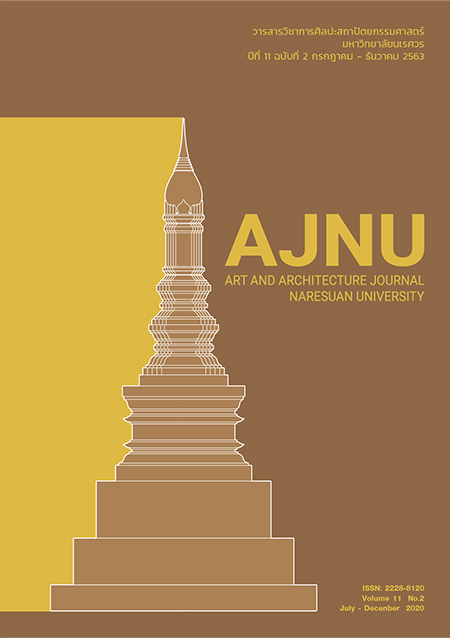The effect of construction defect on customers’ per ceived value and satisfaction : a case study of a condominium
Main Article Content
Abstract
The problem of building defects in new construction can impact value and satisfaction. Condominium buildings, which have become popular forms of housing and investment, are one example. Although many factors affect a customer's decision to buy a condominium, construction quality is an important one. This study focuses on the impact of building defects on customers’ perceived value and satisfaction. Building damage caused by moisture and cracks, at four different levels, was assessed by rating customer acceptance and satisfaction levels, drawn from a sample survey of 60 people. The sample included both construction experts and customers. The results show that both groups tend to report similar acceptance and satisfaction levels with the different defects. However, when the different condition levels were compared, differences were found at the 10-20% condition level. The acceptance levels by the experts were affected by their knowledge of how those defects can be fixed and how much the repairs will cost. The acceptance levels by the customers, on the other hand, were affected mostly by what they actually saw in the buildings. Thus, the acceptance of building defects varies according to the experience and knowledge of each person. Although the perceptions of both groups were similar, the perceived value and acceptance of condition defects at level 30% and 40% were different. This might partly explain why building defects continue to appear in new buildings, despite having been inspected by experts.
Article Details
References
ชินกร น้อยคำยาง. (2552). การเปรียบเทียบผลการทดสอบสถิติพาราเมตริกและนอนพาราเมตริก ในการทดสอบความ แตกต่างระหว่างประชากรสองกลุ่มที่อิสระจากกัน (การศึกษามหาบัณฑิต), มหาวิทยาลัยศรีนครินวิโรฒ, กรุงเทพฯ.
โชติวุฒิ เหล่าไพโรจจน์. (2555). ปัจจัยกำหนดราคาคอนโดมิเนียมในเขตกรุงเทพมหานคร (เศรษฐศาสตร์ มหาบัณฑิต), มหาวิทยาลัยธรรมศาสตร์, กรุงเทพฯ.
ยุพิน คำนึงเนตร. (2547). การศึกษาตัวแปรที่มีผลต่อราคาประเมินอาคารชุดพักอาศัย: กรณีศึกษา อาคารชุดพักอาศัยในเขตเมืองพัทยา จังหวัดชลบุรี (คพ.ม.), จุฬาลงกรณ์มหาวิทยาลัย, กรุงเทพฯ.
วิญญู วาณิชศิริโรจน์. (2561) ตรวจสุขภาพคอนโดก่อนรับโอน. กรุงเทพฯ: อมรินทร์ พริ้นติ้งแอนด์พับลิชชิ่ง.
อนันต์ เชี่ยวชาญกิจการ. (2561). โมเดลความสัมพันธ์เชิงสาเหตุของการรับรู้การดำเนินงานบริการด้านคุณภาพบริการคุณค่าบริการปฏิสัมพันธ์การบริการต่อความพงึพอใจและความตั้งใจเชิงพฤติกรรมของลูกค้าที่มาใช้บริการสปาในอำเภอหัวหิน จังหวัดประจวบคีรีขันธ์. วารสารมนุษยศาสตร์และสังคมศาสตร์นายเรืออากาศ, 6(ธันวาคม), 63-79.
เอกรินทร์ มหาวิริโย. (2559). จุดบกพร่องงานก่อสร้างและค่าซ่อมแซมในโครงการก่อสร้างอาคารสูง (วิศวกรรมศาสตรมหาบัณฑิต), มหาวิทยาลัยธรรมศาสตร์, ปทุมธานี.
Chinny, N. E. (2007). Improved client satisfaction: A strategic approach in the construction sector. PRoBE 2007. The third Scottish conference for postgraduate researchers of the built and natural environment, 111-120.
Gaspar, P.L. and Brito, J. d. (2008). Quantifying environmental effects on cement-rendered facades: A comparison between different degradation indicators. Building and Environment, 43, 1818-1828.
Haddadi, A., Temeljotov-SalaJ, A., Foss, M. and Klakegg, O. J. (2016). The concept of value for owners and users of building – A literature study of value in different contexts. Social and Behavioral Sciences, 226, 381-389.
Hopkin, T., Lu, S., Rogers, P. and Sexton, M. (2017). Key stakeholder’s perspectives towards UK new-build housing defects. Building Pathology and Adaptation, 35(2), 110-123.
Jaeger, S.R., Machin, L., Aschemann-Witael, J., Antunes, L., Harker, F.R. and Ares, G. (2018). Buy, eat or discard? A case study with apples to explore fruit quality perception and food waste. Food Quality and Preference, 69, 10-20.
Karna, S. (2004). Analysing customer satisfaction and quality in construction the case of public and private customer. Nordic Journal of Surveying and Real Estate Research, Special Series 2, 67-80.
Martin-Consuegra, D., Molina, A. and Esteban, A. (2007). An integrated model of price, satisfaction and loyalty: an empirical analysis in the service sector. Journal of Product & Brand Management, 16(7), 459-468.
Meor Hansan, M. I. M., Abd Razak, N. N. A., Endut, I. R., Abu Samah, S. A., Ridzuan, A. R. M. and Saaisin, S. (2016). Minimizing defects in building construction project. Jurnal Teknologi (Sciences & Engineering), 78:5(2), 79-84.
Fauzi, S. N. F. M., Yusof, N. A. and Abidin, N. Z. (2012). The relationship of housing defects, occupants’ satisfaction and loyalty behavior in build-then-sell houses. Social and Behavioral Sciences, 62, 75-86.
Miron, L. I. G. and Formoso, C. T. (2003). Client requirement management in building projects. The 11th Annual conference of the international group for lean construction. Virginia, USA.
.
Miron, L. I. G. and Formoso, C. T. (2010). Value generation in social housing projects: A case study on the city entrance integrated program in Porto Alegre, Brazil. Proceeding IGLC-18, 181-190.


